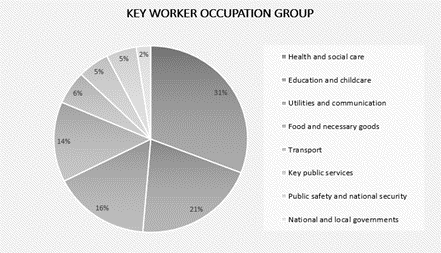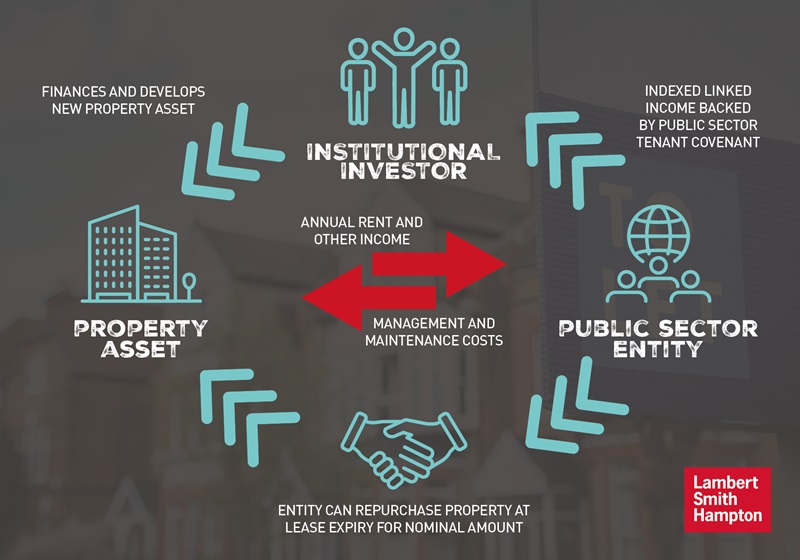A Post Covid-19 Key Worker
The National Planning Policy Framework, 2023, defines essential local workers as public sector employees (‘key workers’) who provide frontline services such as NHS staff, teachers, police, firefighters, military personnel, social care and childcare workers.
The COVID-19 pandemic has redefined those who we consider as an “essential local worker” to maintain a functioning socio-economic society. A debate exists whether this definition should be widened to include a diverse scope of key workers following the pandemic.
The ONS carried out a study in 2020, shown in the graph to the left, illustrating the occupation groups for key workers. We observe that the majority worked in health and social care (31%), education and childcare (20%), and food and necessary goods (14%).

Source: Office for National (ONS) Statistics - Annual Population Survey 2020
We expect that the split would remain relatively similar for 2022 to 2023 with the healthcare sector representing the largest occupation group of key workers.
Increased cost of living
A variety of factors, directly and indirectly, owing to the current economic and political conditions has led to a significant increase to inflation and consequently the cost of living. For a large part of society, it has become clear that income has become insufficient in covering housing costs particularly in London and the South East.
The inevitable housing crisis has accelerated over recent months, with an increase to the private rented sector where many tenants have turned to occupying houses in multiple occupation (HMOS). The higher demand for HMOs has increased the price of single let rooms within house shares, which key workers would typically seek to inhabit. Local Authorities have been unable to keep up with the demand for affordable housing, yet the Government has equally placed stringent requirements on the planning system for new housing. The toughened planning regulations coupled with an already COVID-19 delayed pipeline and impacts from the economy, has further restricted supply.
A vicious cycle of costs
At a time, where the public purse is tighter than ever before, the Government faces fresh funding challenges with “Schoolgate” and RAAC, as well as the promise of the New Hospital Programme. As such, the provision of social housing may have fallen down the list of priorities. This has resulted in many healthcare key workers being unable to afford suitable accommodation within a commutable distance of the workplace. In certain areas of the healthcare sector, this has led to a reduction in the workforce resulting in staff shortage and high agency / temp staff costs.
Financing and delivery options
- NHS Trust funded
- Leasing: Operating leases, Sale and leaseback arrangements, and Income Strip leasing
- PFI / PPP project finance
- Joint Venture partnership with the private sector
- Government grant funding
Following the abolition of PFI models in October 2018, the Government are yet to confirm what, if anything at all, will replace the former preferred method of funding public sector property and infrastructure projects. Although an ideal option, NHS funding and Government Grants appear to be highly unlikely noting the current estimated high risk backlog costs at £10.2bn as published by ERIC 2021/2022. One option could be a JV with the private sector; however, this would still require the Entity itself to provide an element of funding and incur costs, which is highly unlikely to be available.
Sale and Leaseback vs. Income Strip Leasing
A popular route to funding over the years has been the leasing option, with sale and leasebacks previously being the preferred method of releasing funds within primary care. More recently, the exponential rise of income strip leasing has grown particularly across the healthcare sector who have benefited from the released funds by reinvesting this within their existing estate.
A sale and leaseback is where an entity sells the freehold interest to an investor and signs a long lease (typically 20 years) with the same investor, as a tenant to occupy the sold premises. This is in exchange for an upfront lump sum payment from the investor to the vendor. The lease will include strong index linked rent reviews which are usually on an annual basis and therefore creates an investment value associated with the lease in place. A sale and leaseback is often used for office accommodation and car parks.
An income strip leasing is similar in principle, with one key difference. An entity still sells the freehold interest to an investor and leases back the premises by way of a long lease (usually 30 to 40 years). In this instance, the Entity has the right to repurchase the asset for a nominal amount upon lease expiry. The capital receipts released from the sale are used to finance the development of an asset required by the entity for example: funding key worker accommodation.
Traditional Income Strip Model

Investor Interest
Potential Benefits
The capital receipts from the sale of the freehold interest can be reinvested back to forward fund the development of the new key worker accommodation. There are several benefits to the entity by choosing an income strip option:
- Development and financial risk associated with new accommodation is transferred from the entity to the investor
- Should there be a gap between the rental income and expenditure, the entity can benefit from a profit rent
- The entity will have an option to purchase the reversionary property interest for a nominal amount upon lease expiry
- Funds are released to the entity on practical completion of the development / execution of the occupational lease
- Income generated from the underlying asset is likely to match lease payments
- The entity has ability to generate income from the accommodation following lease expiry
- Accommodation built would be in line with the entity’s specifications and therefore high quality and fit for purpose
- Provision of key worker accommodation to attract and retain staff, particular in areas of high rents and in rural locations
Potential Risks
- The rental income achievable from the key worker rooms will be subject to market conditions
- A shortfall in income could arise, if the rents derived from the rooms do not keep in line with the increase of the lease rents (growing by RPI / CPI) over the full period of the occupational lease
- Income Risk – ability to generate sufficient income to meet rental payments
- Inflation Risk – ability to pass on inflation linked price increases to customers
- The costs associated with running asset may be greater than expected e.g maintenance, voids etc
NHS Requirements
- Any sale and leaseback arrangement should provide value for money and be supported by a fully documented audit trial on how the decision was reached.
- The NHS organisation must ensure that its right to continue to use the facility is preserved for as long as it is likely to be required.
- A comparison between the Government’s cost of capital and the lessor’s likely cost of capital should be made.
Final Comments
Get in touch

Stephen Hemming
Senior Director – National Head of Planning Consultancy

Email me direct
To:
REGISTER FOR UPDATES
Get the latest insight, event invites and commercial properties by email

